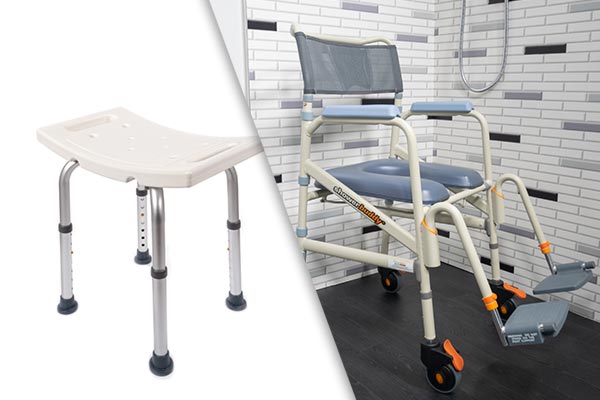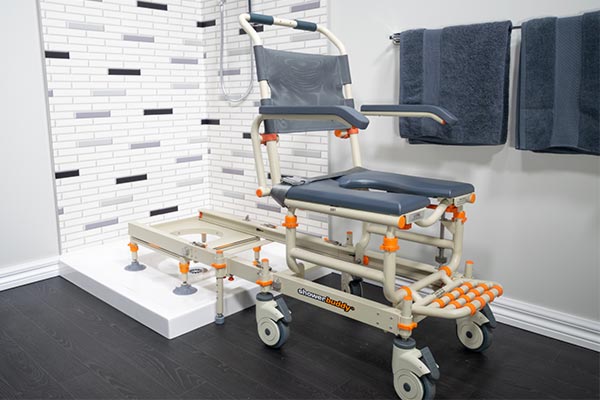-
If you’re doing online research about shower chairs and stools, you’ll probably have come to realise; there’s a huge spectrum of solutions available, and not all of them are good. One of the more common questions the mobility community has around bathroom assistive equipment is around the difference between the in-shower plastic stools and a shower chair. To add more confusion, plenty of low quality shower stools are presented as shower chair systems which are not helpful for the end user. It’s no surprise that many of our clients come to Showerbuddy after trying a number of cheap and poor quality options.
In this guide we’ll provide some clear differences between the low quality shower stool and a proper shower system so you’ve got useful information to make a decision on what’s right for you.
-
![]()
MODEL SB1: Once in the shower the SB1 it is able to pivot to aid in bathing. (Shown after the transfer bridge had been removed).
-
The: cost
-
Shower stools are typically inexpensive
If you do a quick google search for ‘shower stools’, chances are you’ll find a number of product ads and listings for stools that are low cost. These units are usually built with a basic plastic seat and hollow metal legs. They may also have some rudimentary rubber grip feet.
The challenging factor for OTs and users in finding an appropriate bathroom mobility option is that the market is a real mix between low quality options and sophisticated assistive equipment. For the purposes of this guide, we’ll refer to shower stools when discussing the basic, retail sold, cheap options.
There’s a simple reason as to why basic shower stools are inexpensive; they don’t cost much to make and they’re a product that’s designed to sell at scale for a variety of mobility types. Those who get the most value out of a basic shower stool aren’t likely dealing with significant impaired movement.
Shower chairs may be funded medical equipment
A proper shower chair system may be sold in the same way as low cost options, but in many instances these are acquired through a distributor, medical professional referral or the health system. This isn’t to say users can’t buy a proper shower chair system in a retail environment – but these will likely be through specialist mobility equipment companies vs. a chain store that sells homewares and/or bathroom products of all types.
Funding is accessible for advanced shower chairs as these are typically more expensive than a basic stool. Even still, a shower transfer system is much more affordable than a full bathroom remodel. Depending on where you’re based you may be able to get the total cost of a shower chair covered by the public health system or through insurance. Learn more about funding in our dedicated guide.
-
![]()
Quality: Materials
-
Shower stools are made of low quality plastic and metal
A basic shower stool isn’t made with the level of care and attention detail that more specialist assistive equipment is. In fact the materials used are typically low grade plastic that’s basic function is to be easy to clean and dry. The issue with poor quality plastic is over time it will wear through tension under load.
The frame of a shower stool which consists of the seat (and user) bracing and legs need to be resilient to constant usage over a course of years. Unfortunately many cheap shower stools don’t offer a frame built from long-lasting metal. This can lead to bending, buckling and failure while in use.
There’s another overlooked element of a shower stool that can make the difference between function and failure – and that’s the fittings to keep parts in place. If bolts, screws, washers and feet aren’t securely fastened or made from weak materials to save production costs, there’s more chance the whole unit can lose components or fall apart over the course of its lifetime.
Proper shower chairs should be designed for user comfort and with long lasting materials
On the flipside, proper assistive technology that’s designed for use by severely impaired users and their support people will more than likely provide superior parts and just as importantly – build quality.
A good quality shower chair will be made from medical grade aluminum, stainless steel, PVC and other proven materials. These will be chosen for their durability over time, and their ability to enable smooth function every day.
But it’s how these products are assembled that’s often the most noticeable difference to users. A basic shower chair may be produced with just a few basic steps to get the unit shipped, whereas proper assistive technology undergoes expert welding and machining to ensure frame, fittings, seating and rests are all working perfectly.
This build quality doesn’t just help with the durability of the product, but makes installation for families and OTs much simpler.
-
Product: Functions
-
Shower stools don’t support users with significant mobility issues
The problem with a basic shower stool is that anyone who struggles to get in and out of the shower will not benefit from these units. While someone who simply experiences fatigue somewhat and needs a seat might find some function in a basic, inexpensive stool, they will not be served properly long term if mobility is continually degrading.
Anyone with notable disabilities would not likely benefit from these mass produced cheap shower stools. A paraplegic for example would require more sophisticated support equipment to conduct safe bathing.
A full shower chair system will have multiple features to support the user’s safe bathing
A shower transfer chair has to execute a more complex list of tasks beyond sitting in the shower. Moving around the bathroom, using the toilet and adjusting body positioning are all common requirements for a mobility impaired individual and a good shower chair system should accommodate this.
It’s these additional features of a proper shower chair that make them the logical choice for so many around the globe over a cheap alternative. Elderly users who experience reduced ease of movement in the bathroom can benefit from a system that may be initially more than is required, but over time becomes an essential companion to dignified bathing.
The transfer: process
-
![]()
-
Shower stools don’t support the transfer process
One of the more hazardous moments in the bathroom is getting into and out of the shower. A shower stool’s job starts and ends with seating. Even if you find a shower stool that’s more of a ‘transfer bench’ – an elongated stool that reaches over the edge of the bathtub, the transfer still requires a carer to lift and shift the user. This process is responsible for so many avoidable injuries to carers due to heavy straining with irregular weight distribution.
Otherwise, a shower stool will not provide any assistance with access and exit. Someone with compromised motor function is therefore reliant on the carer or family member for big parts of the bathroom process – including moving onto a toilet.
Therapists have seen numerous examples of clients slipping or falling from these low cost transfer benches too, there is little seated support and with transfers being a difficult process extreme care is needed, again suggesting a more client focused product be used.
The right shower chair enables lift-free bathroom usage and transfers
A full shower transfer system removes all of this headache. Provided the system is designed for the user’s specific bathroom configuration, there should be no additional transferring once they are sitting on the shower chair. Users should be able to be moved between the toilet, shower and basin area without carer lifts.
The Showerbuddy range of transfer products are built to clear almost any bathtub or step in shower edge with a chair, bridge and shower base combination. This approach removes human effort and places the load on proven assistive equipment.
-
Warranty & Support. Why you should: opt for quality
-
A basic shower stool won’t come with any ongoing support
If you’ve ever tried contacting the manufacturer of a mass produced, low quality product you might have learned just how hard it can be to get any support or even response to an issue. Low quality shower stools are often bought from large chain retailers who themselves may have good customer service insofar as returns and refunds, but will lack the depth of product knowledge to support users beyond the purchase.
A proper shower chair should come with warranty and long term customer support
When a mobility impaired person and their family choose a proper shower chair system from a reputable bathroom mobility company, they should expect great customer service as well as a great product. A shower transfer system should be a fully integrated solution from the network of distributors, occupational therapists who help assess the user’s needs, to the product range, accessories and support to troubleshoot any issues. If all of these elements work together, the end user enjoys a better experience.
The product’s quality itself should be guaranteed when opting for a proper shower transfer system – look for the structural components like the frame to be covered through warranty.
Occupational therapists aren’t typically confident in the capability of a basic shower stool
While we can’t speak for every occupational therapist out there, we directly deal with thousands across the planet. And from our conversations, there’s one thing that’s reasonably consistent – the low quality shower stools aren’t ideal for their clients.
Even more common are our chats to families of someone with a mobility impairment; they’ve often tried the cheap option and had little success or even a bad experience with it.
An occupational therapist’s job is to help clients conduct daily life easier with a careful plan and assessment of needs. This will prioritise the safety and comfort of the client – something which a basic shower still is unlikely to offer outside of the lightest of bathroom needs.
OTs endorse and help supply good shower mobility equipment
It stands to reason then, that occupational therapists will strive to get good quality assistive equipment in the hands of families they’re helping. The OT’s plan will include how the carer (be it a professional or family member) will provide assistance while reducing their own risk of injury or accident.
OTs typically have relationships with equipment providers or know the channels to go through in order to acquire these products for their clients. If you’re a user or family member, chat to your OT about options for a shower transfer chair.
Our guide here would be to think about current needs and find out from a healthcare provider such as a doctor or occupational therapist whether existing ailments are likely to evolve into further reduced motion. If this is the case, a permanent shower fold-out bench is unlikely to be the best option.
Learn more about: Showerbuddy’s range
Are you interested in a shower chair solution that doesn’t just provide users with more comfort and support during bathing, but a totally strain-free transfer system and full commode solution? Head over to our products section to browse the range.




